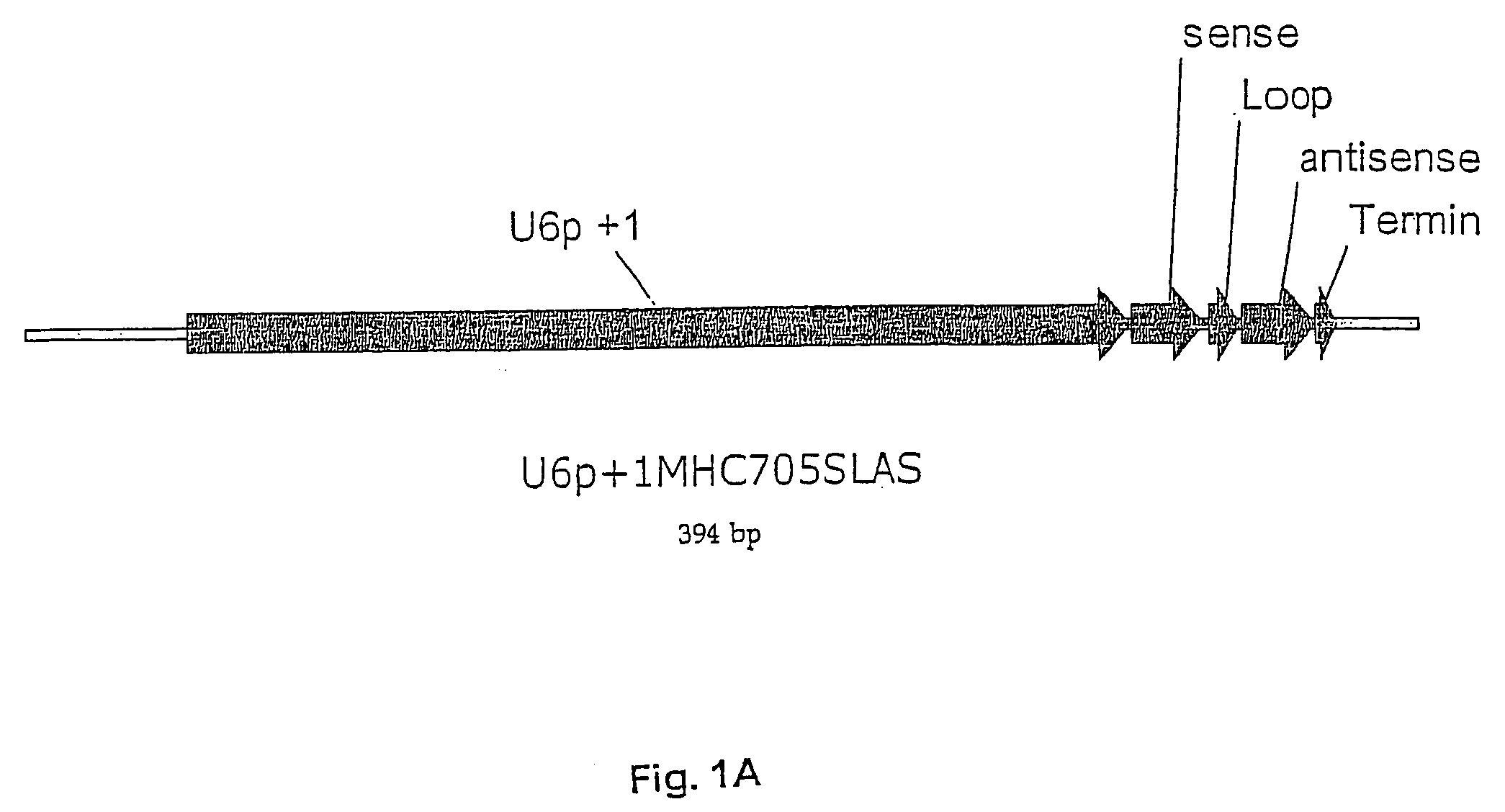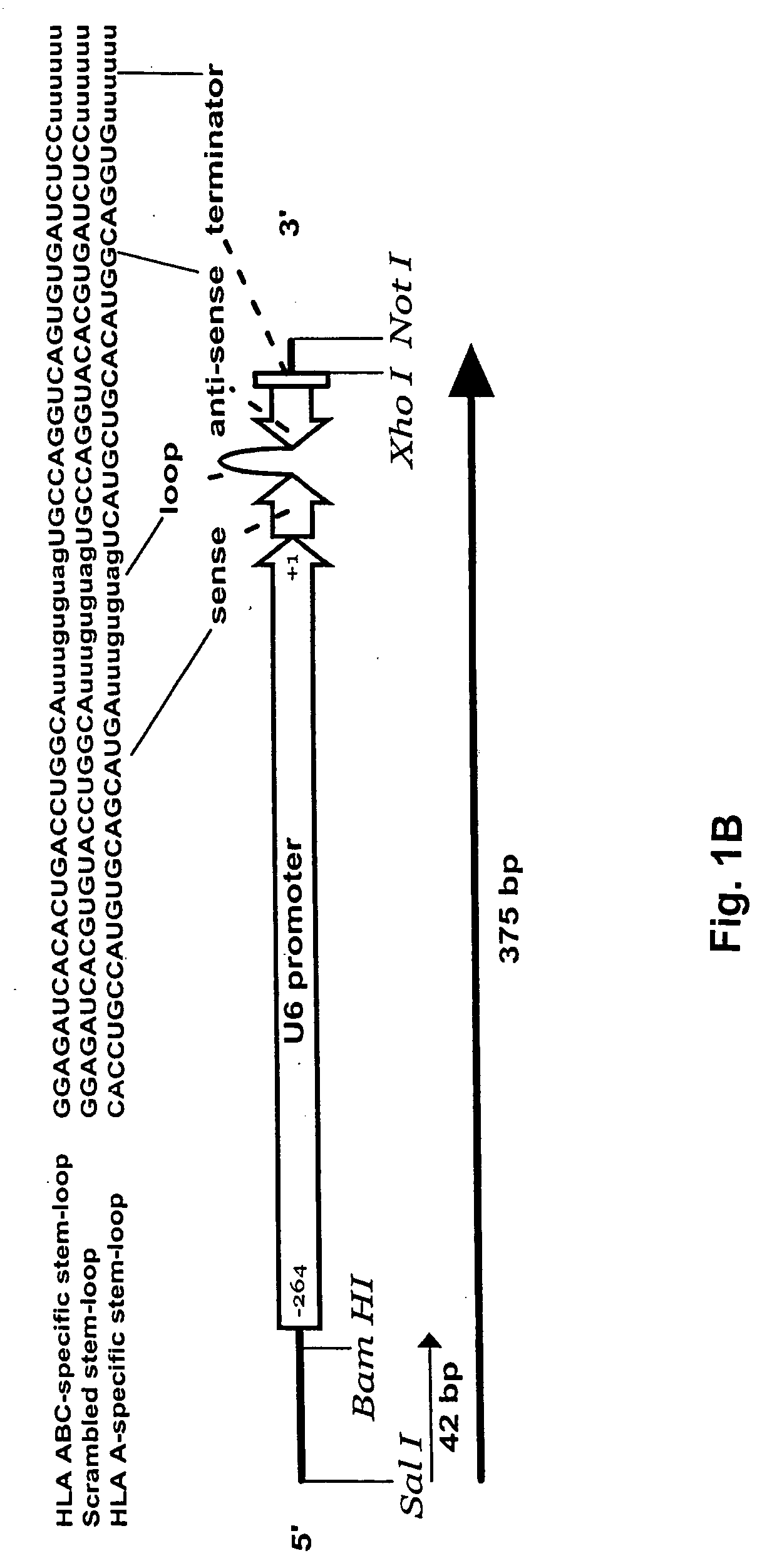Amplifying interfering RNA (RNAi) expression and effects
a technology of interfering rna and expression, applied in the field of interfering rna (rnai), can solve the problems of insufficient interfering effect of expressed sirna, inability to predict relative effectiveness of expressed sirna, and inability to achieve desired phenotypes
- Summary
- Abstract
- Description
- Claims
- Application Information
AI Technical Summary
Benefits of technology
Problems solved by technology
Method used
Image
Examples
example 1
[0091] MHC class I gene expression on U293T cells transfected with synthetic double-stranded RNA specific for conserved HLA class I sequence was examined for down-regulation. U293T cells were plated in log-phase growth and transfected with 218 nM of double-stranded RNA suspended in oligofectamine (Invitrogen). After 96 hours, the cell-surface expression of HLA class I was determined by flow cytometry using FITC-conjugated anti-HLA ABC (PharMingen).
[0092] HLA A2 gene expression on U293T cells transfected with synthetic double-stranded RNA specific for conserved HLA class I sequence also was examined for down-regulation. U293T cells were plated in log-phase growth and transfected with 218 nM of double-stranded RNA suspended in oligofectamine (Invitrogen). After 96 hours, the cell-surface expression of HLA class I was determined by flow cytometry using FITC-conjugated anti-HLA A2 (PharMingen).
[0093] Examples of siRNA molecules that can reduce the cell surface expression of MHC class ...
example 2
[0095] U6 pol III promoter was joined to the 705 stem-loop sequence (GGAGATCACACTGACCTGGCAtttgtgtagTGCCAGGTCAGTGTGATCTCC [SEQ ID NO: 1]) or scrambled 705 stem-loop sequence (GGAGATCACGTGTACCTGGCAtttgtgtagTGCCAGGTACACGTGATCTCC [SEQ ID NO: 2]) by PCR. The 705 stem-loop sequence is complimentary to almost all human class I genes. This sequence is conserved in almost all HLA classical (and some non-classical) class I genes. The correct sequence was verified (data not shown).
example 3
[0096] As shown in FIG. 1F, a DNA expression plasmid was constructed to contain and express 6 copies of the U6 promoter and stem-loop cassette having a scrambled sequence. The U6 PCR cassette was constructed to have Sal 1 and Xho 1 compatible restriction sites at its 5′ and 3′ ends, respectively. The cassette was cloned into the unique Xho I site of the EGFP / diipMGNeo expression vector, destroying the 5′ Sal 1 site with a Sal 1 / Xho 1 ligation and recreating a unique Xho 1 site at the 3′ end. This new Xho 1 site was used for subsequent clonings of additional U6 cassettes using the same cloning strategy. In addition to the multiple U6 shRNA cassettes, the expression vector contains an EGFP reporter gene under control of the hybrid human elongation factor I (ELF1) and a-region promoter in the pMG vector purchased from Invitrogen. The correct construction of the DNA plasmids was validated by RE digestion resolved on agarose gel and by DNA sequence analyses (data not shown).
PUM
| Property | Measurement | Unit |
|---|---|---|
| Fraction | aaaaa | aaaaa |
Abstract
Description
Claims
Application Information
 Login to View More
Login to View More - R&D
- Intellectual Property
- Life Sciences
- Materials
- Tech Scout
- Unparalleled Data Quality
- Higher Quality Content
- 60% Fewer Hallucinations
Browse by: Latest US Patents, China's latest patents, Technical Efficacy Thesaurus, Application Domain, Technology Topic, Popular Technical Reports.
© 2025 PatSnap. All rights reserved.Legal|Privacy policy|Modern Slavery Act Transparency Statement|Sitemap|About US| Contact US: help@patsnap.com



